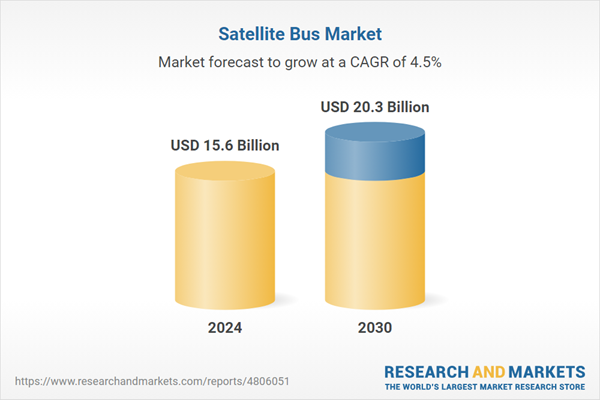The global market for Satellite Bus was valued at US$15.6 Billion in 2024 and is projected to reach US$20.3 Billion by 2030, growing at a CAGR of 4.5% from 2024 to 2030. This comprehensive report provides an in-depth analysis of market trends, drivers, and forecasts, helping you make informed business decisions. The report includes the most recent global tariff developments and how they impact the Satellite Bus market.
Segments: Satellite Size (Small (1kg - 500kg), Medium (1,501kg - 2,500kg), Large (Over 2,500kg)); Application (Earth Observation & Meteorology, Communication, Surveillance & Security, Mapping & Navigation, Scientific Research & Exploration, Other Applications).
Geographic Regions/Countries: World; United States; Canada; Japan; China; Europe (France; Germany; Italy; United Kingdom; and Rest of Europe); Asia-Pacific; Rest of World.
The analysts continuously track trade developments worldwide, drawing insights from leading global economists and over 200 industry and policy institutions, including think tanks, trade organizations, and national economic advisory bodies. This intelligence is integrated into forecasting models to provide timely, data-driven analysis of emerging risks and opportunities.
Global Satellite Bus Market - Key Trends and Drivers Summarized
What Role Do Satellite Buses Play in the Design and Deployment of Satellites?
Satellite buses are the foundational platforms that support all the components of a satellite, including the payload, propulsion system, power supply, and communication systems. They provide the necessary structural, thermal, and electrical support for satellite operations in space. Satellite buses are used in various types of satellites, such as communication satellites, Earth observation satellites, navigation satellites, and scientific research satellites. The increasing demand for satellite services, including communication, navigation, Earth observation, and space exploration, is driving the need for advanced satellite bus platforms that offer modularity, scalability, and reliability. Satellite buses are designed to meet the specific mission requirements, and the development of standardized and flexible bus architectures is enabling faster deployment, reduced costs, and greater mission flexibility. As the satellite industry continues to expand, the role of satellite buses as the backbone of modern space missions is becoming more critical.How Are Technological Advancements Shaping the Development of Satellite Buses?
Technological advancements in satellite bus design and manufacturing are driving significant improvements in their performance, reliability, and adaptability. The development of modular and scalable satellite bus architectures is allowing for greater customization and flexibility, enabling satellite operators to tailor the bus to specific mission needs and payload requirements. The integration of electric propulsion systems in satellite buses is reducing launch costs and extending mission lifespans by providing more efficient and lightweight propulsion solutions. Advancements in materials, such as carbon composites and lightweight alloys, are enhancing the durability and reducing the weight of satellite buses, contributing to lower launch costs and improved payload capacity. The emergence of small and nano-satellite buses, designed for low Earth orbit (LEO) missions, is enabling more frequent and cost-effective satellite deployments, particularly for Earth observation, communication, and scientific research applications.What Market Trends Are Influencing the Satellite Bus Industry?
The satellite bus market is shaped by several key trends, including the growth of low Earth orbit (LEO) satellite constellations, the increasing focus on reducing satellite weight and launch costs, and the rising demand for standardized and interoperable bus platforms. The expansion of LEO satellite constellations for communication, Earth observation, and broadband internet services is driving the demand for small and lightweight satellite buses that can support multiple launches and rapid deployment. The focus on reducing satellite weight and launch costs is encouraging the development of satellite buses with electric propulsion systems, lightweight materials, and compact designs. The trend towards standardization and interoperability of satellite bus platforms is enhancing the flexibility and scalability of satellite missions, allowing operators to mix and match payloads and bus components more efficiently. Additionally, the growth of space exploration and deep space missions is creating new opportunities for advanced satellite bus designs that can support long-duration and high-risk missions.What Are the Key Drivers of Growth in the Satellite Bus Market?
The growth in the satellite bus market is driven by several factors, including advancements in modular and scalable bus architectures, increasing demand for LEO satellite constellations, and the rising focus on reducing satellite weight and launch costs. The development of flexible and standardized satellite bus platforms is enhancing their appeal across various applications, from Earth observation and communication to scientific research and space exploration. The growth of LEO satellite constellations, particularly for broadband internet services and remote sensing, is expanding the demand for small and nano-satellite buses that can support multiple launches and rapid deployment. The increasing emphasis on reducing satellite weight and launch costs is driving the adoption of electric propulsion systems and lightweight materials in satellite bus design. Additionally, the trend towards customization and interoperability of satellite bus platforms is creating new opportunities for innovation and market expansion.Report Scope
The report analyzes the Satellite Bus market, presented in terms of units. The analysis covers the key segments and geographic regions outlined below.Segments: Satellite Size (Small (1kg - 500kg), Medium (1,501kg - 2,500kg), Large (Over 2,500kg)); Application (Earth Observation & Meteorology, Communication, Surveillance & Security, Mapping & Navigation, Scientific Research & Exploration, Other Applications).
Geographic Regions/Countries: World; United States; Canada; Japan; China; Europe (France; Germany; Italy; United Kingdom; and Rest of Europe); Asia-Pacific; Rest of World.
Key Insights:
- Market Growth: Understand the significant growth trajectory of the Small (1kg - 500kg) segment, which is expected to reach US$9.1 Billion by 2030 with a CAGR of a 5.1%. The Medium (1,501kg - 2,500kg) segment is also set to grow at 4.1% CAGR over the analysis period.
- Regional Analysis: Gain insights into the U.S. market, valued at $4.3 Billion in 2024, and China, forecasted to grow at an impressive 4.0% CAGR to reach $3.2 Billion by 2030. Discover growth trends in other key regions, including Japan, Canada, Germany, and the Asia-Pacific.
Why You Should Buy This Report:
- Detailed Market Analysis: Access a thorough analysis of the Global Satellite Bus Market, covering all major geographic regions and market segments.
- Competitive Insights: Get an overview of the competitive landscape, including the market presence of major players across different geographies.
- Future Trends and Drivers: Understand the key trends and drivers shaping the future of the Global Satellite Bus Market.
- Actionable Insights: Benefit from actionable insights that can help you identify new revenue opportunities and make strategic business decisions.
Key Questions Answered:
- How is the Global Satellite Bus Market expected to evolve by 2030?
- What are the main drivers and restraints affecting the market?
- Which market segments will grow the most over the forecast period?
- How will market shares for different regions and segments change by 2030?
- Who are the leading players in the market, and what are their prospects?
Report Features:
- Comprehensive Market Data: Independent analysis of annual sales and market forecasts in US$ Million from 2024 to 2030.
- In-Depth Regional Analysis: Detailed insights into key markets, including the U.S., China, Japan, Canada, Europe, Asia-Pacific, Latin America, Middle East, and Africa.
- Company Profiles: Coverage of players such as Airbus Group SE, Applied Aerospace Structures Corporation, Ball Corporation, Boeing Company, The, Centum Electronics Limited and more.
- Complimentary Updates: Receive free report updates for one year to keep you informed of the latest market developments.
Some of the 22 companies featured in this Satellite Bus market report include:
- Airbus Group SE
- Applied Aerospace Structures Corporation
- Ball Corporation
- Boeing Company, The
- Centum Electronics Limited
- Enav S.P.A.
- Honeywell Aerospace Technologies
- Israel Aerospace Industries Ltd.
- Lockheed Martin Corporation
- Magellan Aerospace Corporation
Tariff Impact Analysis: Key Insights for 2025
Global tariff negotiations across 180+ countries are reshaping supply chains, costs, and competitiveness. This report reflects the latest developments as of April 2025 and incorporates forward-looking insights into the market outlook.The analysts continuously track trade developments worldwide, drawing insights from leading global economists and over 200 industry and policy institutions, including think tanks, trade organizations, and national economic advisory bodies. This intelligence is integrated into forecasting models to provide timely, data-driven analysis of emerging risks and opportunities.
What’s Included in This Edition:
- Tariff-adjusted market forecasts by region and segment
- Analysis of cost and supply chain implications by sourcing and trade exposure
- Strategic insights into geographic shifts
Buyers receive a free July 2025 update with:
- Finalized tariff impacts and new trade agreement effects
- Updated projections reflecting global sourcing and cost shifts
- Expanded country-specific coverage across the industry
Table of Contents
I. METHODOLOGYII. EXECUTIVE SUMMARY2. FOCUS ON SELECT PLAYERSIII. MARKET ANALYSISIV. COMPETITION
1. MARKET OVERVIEW
3. MARKET TRENDS & DRIVERS
4. GLOBAL MARKET PERSPECTIVE
UNITED STATES
CANADA
JAPAN
CHINA
EUROPE
FRANCE
GERMANY
ITALY
UNITED KINGDOM
REST OF EUROPE
ASIA-PACIFIC
REST OF WORLD
Companies Mentioned (Partial List)
A selection of companies mentioned in this report includes, but is not limited to:
- Airbus Group SE
- Applied Aerospace Structures Corporation
- Ball Corporation
- Boeing Company, The
- Centum Electronics Limited
- Enav S.P.A.
- Honeywell Aerospace Technologies
- Israel Aerospace Industries Ltd.
- Lockheed Martin Corporation
- Magellan Aerospace Corporation
Table Information
| Report Attribute | Details |
|---|---|
| No. of Pages | 234 |
| Published | April 2025 |
| Forecast Period | 2024 - 2030 |
| Estimated Market Value ( USD | $ 15.6 Billion |
| Forecasted Market Value ( USD | $ 20.3 Billion |
| Compound Annual Growth Rate | 4.5% |
| Regions Covered | Global |









